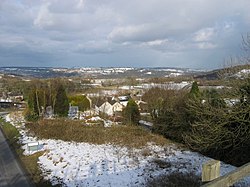Middleton-by-Wirksworth
| Middleton-by-Wirksworth | |
| Derbyshire | |
|---|---|
 Middleton from the High Peak Trail | |
| Location | |
| Grid reference: | SK277559 |
| Location: | 53°4’60"N, 1°34’60"W |
| Data | |
| Population: | 775 (2011) |
| Post town: | Matlock |
| Postcode: | DE4 4 |
| Dialling code: | 01629 |
| Local Government | |
| Council: | Derbyshire Dales |
| Parliamentary constituency: |
Derbyshire Dales |
Middleton-by-Wirksworth, or simply Middleton, is an upland village in Derbyshire, a mile north of Wirksworth. The suffix of the name serves to distinguish this Middleton from Middleton-by-Youlgreave, just seven miles away.
Middleton is dependent on the market town of Wirksworth for many of its services, such as its health centre, leisure centre, high school (the Anthony Gell School) and nearby shops. The closest railway station to Middleton is Wirksworth on the Ecclesbourne Valley Railway.
The population of the parish as taken at the 2011 Census was 775.
History
In 1086, Middleton was a berewick (a supporting farm) of the town and manor of Wirksworth.
In more recent times, Middleton was formerly known for its lead mines and high quality limestone quarries, including the underground quarry site at Middleton Mine. The Middleton Mine networks underground for approximately 25 miles, with tunnels on three different levels running under Middleton Moor to the Hopton Wood quarry works at the other side of the hill below Ryder Point Works’. Part of the tunnel collapsed in the 1980s leaving a noticeable depression in the ground above on the eastern side of Middleton Moor.
It was limestone which expanded Middleton from a hamlet to a village It is one of the few Derbyshire villages in the limestone area that has a ‘perched’ water table due to the impervious volcanic rock and shale formations within its topology. This availability of water was the incentive to the development of quarries here.
The former Cromford and High Peak Railway passes close by the village. The local quarries were linked to this line by a short branch spur, Killer's Branch, part of which now forms the track bed of the Steeple Grange Light Railway. The branch line was operational until the late 1960s.
In 1918-19, D. H. Lawrence and his wife Frieda rented Mountain Cottage, which stands below the B5023 on the north-west side of village as the road descends towards the Via Gellia. Lawrence also reputedly spent time at Woodland Cottage (formerly known as The Woodlands) on the opposite side of New Road. While living in Middleton during the bitter winter of 1918-1919, Lawrence wrote the short story A Wintry Peacock (published in 1921), which is set in the immediate locality.
About the village
In the 1970s, the disused track bed of the Cromford and High Peak Railway and some surrounding land were purchased by the council and the Peak Park Planning Board, who then worked collaboratively to turn the former railway into the 17-mile High Peak Trail for walkers and cyclists. Middleton Top lies near the southern end of the trail, which starts at High Peak Junction. There is a car park and visitor centre at Middleton Top.
Middleton Top Engine House houses a preserved steam engine formerly used to haul trains up the Middleton Incline, 700 yards long at a 1-in-8 (12.5%) gradient. The engine, built by the Butterley Company of Ripley in 1829, still runs for demonstration purposes and is occasionally open to the public.
The northern part of the village on the west side of the main road out towards New Road is called 'The Hall' due to the location of the now demolished Middleton Hall.
Outside links
| ("Wikimedia Commons" has material about Middleton-by-Wirksworth) |
- Middleton-by-Wirksworth Village
- Notes on the Cromford and High Peak Railway
- British Geological Survey:
- A genealogy of the Brooks family of Middleton by Wirksworth
References
- Kinkead-Weekes, Mark: 'D. H. Lawrence: Triumph to Exile, 1912-1922' (Cambridge University Press, 1996) ISBN 0-521-25420-5